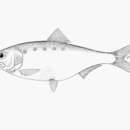Diagnostic Description
provided by Fishbase
Body `shad-like', usually rather deep and compressed. Total gill rakers 50 to 180, long and thin, distinctly longer than filaments. Teeth poorly developed in jaws, sometimes barely detectable. A black spot posterior to gill opening and occasionally further black spots on flank in some cases.
- Recorder
- Crispina B. Binohlan
Life Cycle
provided by Fishbase
Depending on the subspecies some are semi-anadromous and spawn in fresh or slightly saline waters, mainly in the lower reaches, whereas others are practically marine and spawn in brackish or even fully saline oceanic waters (Ref.188).There are two migration peaks, one in late April (mostly males) and one in early May (mostly females). Spent fish migrate back to sea. Juveniles migrate to sea during first summer, remaining at sea until they mature (Ref. 59043).
- Recorder
- Crispina B. Binohlan
Migration
provided by Fishbase
Anadromous. Fish that ascend rivers to spawn, as salmon and hilsa do. Sub-division of diadromous. Migrations should be cyclical and predictable and cover more than 100 km.
- Recorder
- Crispina B. Binohlan
Morphology
provided by Fishbase
Dorsal spines (total): 0; Analspines: 0
- Recorder
- Crispina B. Binohlan
Trophic Strategy
provided by Fishbase
Schooling and migratory. Occurs chiefly in brackishwater, but enters freshwaters to spawn. Depending on the subspecies, some are semi-anadromous and spawn in fresh or slightly saline waters, mainly in the lower reaches, whereas others are practically marine and spawn in brackish or even fully saline oceanic waters. One of the most warm-loving Alosa of the Caspian. Feeds on plankton.
- Recorder
- Drina Sta. Iglesia
Biology
provided by Fishbase
Schooling and migratory (Ref. 188); at sea, pelagic in coastal waters with steady current and avoids areas with stable salinity; migrates from sea to mouth of large rives and spawns in fresh- or slightly brackish-water at shallow sites washed by flow of large rivers. Males migrate upriver at 2-3 years, females at 4-5; many individuals reproduce 2-4 seasons. Two migration peaks, one in late April (mostly males), one in early May (mostly females), entering rivers when temperature rises above 10°C. Spawns when temperature is at least 15°C, in May to June. Spawning usually occurs in the upper 3 m. Eggs semi-pelagic and demersal. Spent fish migrate back to the sea; juveniles migrate to sea during first summer, remaining there until they mature. Feeds mainly on zooplankton (copepods and mysids) when at sea (Ref. 59043). Depending on the subspecies (10 subspecies known), some are semi-anadromous and spawn in fresh or slightly saline waters, mainly in the lower reaches, whereas others are practically marine and spawn in brackish or even fully saline oceanic waters. One of the most warm-loving Alosa of the Caspian. Only A. a. caspia of the Caspian Sea is of commercial importance (Ref. 188).
- Recorder
- Crispina B. Binohlan
Importance
provided by Fishbase
fisheries: highly commercial; price category: low; price reliability: questionable: based on ex-vessel price for species in this genus
- Recorder
- Crispina B. Binohlan
Alosa caspia
provided by wikipedia EN
Alosa caspia is a species of clupeid fish, one of the species of shad (genus Alosa) endemic to the Caspian Sea basin.[1]
FishBase treats separately three subspecies from the Caspian:[2]
-
Caspian shad, Alosa caspia caspia (Eichwald, 1838)
-
Enzeli shad, Alosa caspia knipowitschi (Iljin, 1927)
-
Astrabad shad, Alosa caspia persica (Iljin, 1927)
Previously the taxonomic circumscription and geographic range of A. caspia have been broader, encompassing also the Sea of Azov and Black Sea basins.[2][3][4] Up to ten subspecies were recognised; these included forms now classified as Alosa tanaica (and its synonyms) and even the Balkan freshwater endemics Alosa macedonica and Alosa vistonica.[3]
References
-
^ a b Freyhof, J. & Kottelat, M. 2008. Alosa caspia. The IUCN Red List of Threatened Species. Version 2014.3. Downloaded on 18 April 2015.
-
^ a b Froese, Rainer; Pauly, Daniel (eds.) (2014). "Alosa caspia" in FishBase. June 2014 version.
-
^ a b Peter J.P. Whitehead (1985) Subfamily Alosinae In: Clupeoid Fishes of the World - an annotated and illustrated catalog of the herrings, sardines, pilchards, sprats, shads, anchovies and wolf-herrings. FAO Fisheries Synopsis No. 125, Volume 7, Part 1. Rome: UNDP FAO.
-
^ A. caspia (Eichwald,1838) - каспийско-черноморский пузанок Archived 2015-02-13 at the Wayback Machine Позвоночные животные России. sevin.ru

- license
- cc-by-sa-3.0
- copyright
- Wikipedia authors and editors
Alosa caspia: Brief Summary
provided by wikipedia EN
Alosa caspia is a species of clupeid fish, one of the species of shad (genus Alosa) endemic to the Caspian Sea basin.
FishBase treats separately three subspecies from the Caspian:
Caspian shad, Alosa caspia caspia (
Eichwald, 1838) Enzeli shad, Alosa caspia knipowitschi (Iljin, 1927) Astrabad shad, Alosa caspia persica (Iljin, 1927)
Previously the taxonomic circumscription and geographic range of A. caspia have been broader, encompassing also the Sea of Azov and Black Sea basins. Up to ten subspecies were recognised; these included forms now classified as Alosa tanaica (and its synonyms) and even the Balkan freshwater endemics Alosa macedonica and Alosa vistonica.
- license
- cc-by-sa-3.0
- copyright
- Wikipedia authors and editors

